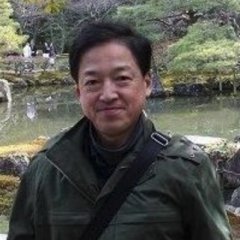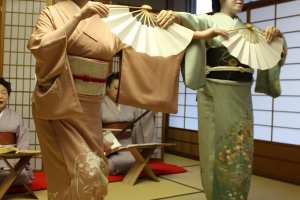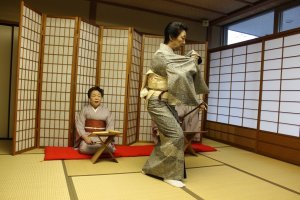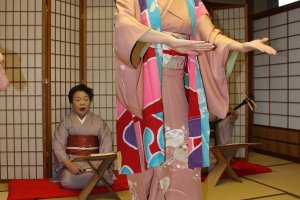Located in the northern part of Fukui Prefecture, roughly in the center of the Sakai Plains, is Awara Onsen, one of the best hot springs in Fukui. In 2004, Awaracho and Kanazumachi merged together and came to be called Awara Onsen (あわら温泉).
Awara Onsen's hot spring is relatively new compared to most onsen. In Meiji 16 (1883), during irrigation work at Awara wetlands, hot spring water gushed up from the earth. About the same time these hot spring waters were discovered, the railroad from Tsuruga to Komatsu was being expanded and upgraded. Awara Onsen quickly became popular as an onsen resort along the way.
At the beginning there were only flat, wide fields. There was little history and no points of interest around the town at the time.You could barely call it a resort to begin with. Yet, perhaps simply because of this flat terrain, Awara became the most attractive part of the area.
Graceful Japanese style rooms with a garden, that was the goal of the Kyoto craftsmen building the area's ryokan. Today, there are few such long-standing traditional hotels which can boast such elegance. Travelers coming from Kyoto, Osaka, or Kobe enter the ryokan and pass through a room where they can see the beautiful garden.
The hot springs of Yaora have wonderful spring quality water for bathing. Fresh marine life hulled in from Mikuni Port, the favorite taste of vegetables right out of the ground from the Sakai Plain and Okuetsu Ohno mountains, and the famous water used in Fukui rice to produce the local sake are just some samples of the refreshing pallet this ryokan serves up.
The staff of the hotel can take care of any traveler's requests. Furthermore, this place is even known as Kansai's salon because the service even satisfies the discerning eyes and ears of the Kansai region, so even they can relax here. On that note, fine foods and sake with geisha performers that rival those of Kyoto's Gion district draw in a capacity crowd for the banquet events.
In Kansai geisha are known as geigi (芸妓) , but in Kanto they are called geisha (芸者). There are basically two kinds of geigi: the tachikata (立方) and the jikata (地方). The tachikata takes the role as the dancer, while the jikata is in charge of narrative story telling or singing and providing the music, usually via shamisen. The warm hospitality of the geigi and worry free atmosphere they create make overnight guests feel right at home. It is said that a group of 250 geigi once supported the Awara Onsen area during its golden age. But times changed.
The ritzy travel companies cast a gray cloud over Awara Onsen and made traveling with friends and family too mainstream with dozens of lodging options. Consequently, geigi skills and traditions which had been passed down for generations were lost. This is because the number of customers that were able to enjoy the deep level conversation skills of the geigi also declined.
After a long time the downward trend was interrupted, and that brings us to today. Even with the odds stacked against them, it is hard to believe what happened next. Starting November 2013, the city kicked off its "Awara Geigi in Awara Sentopia" event in order to revive the geigi tradition by creating opportunities to see them up close and personal.
Set up right in the hot spring baths of Sentopia Awara, on a stage inside a tatami room, dance and songs are performed. While 20 minutes is a short time, to see a real practicing geigi for the first time for just 500 yen can't be beat. All the geigi of Awara are united as one, says geigi Madoka:
"We want to return to the heydays of Awara Onsen. We want all visitors, including the young, to become familiar with the spectacle of traditional arts and enjoy the magic that comes with it. We wish for the whole area of Awara Onsen to become a resort."
To call a geigi to the banquet, it is recommended to ask the proprietress of the hotel. Depending on the hotel, the going rate for a geigi to accompany you by your side (this fee is called hanadai 花代) for the banquet hours is 16000 yen. The geigi will accompany you and not change companions. By the way, in Kanto they call the fee for a geisha's companionship gyokudai (玉代).It is also possible to request which geigi you would like without a special fee.
Talking with a geigi is like talking to your neighborhood female friend. It's very enjoyable and an easy going conversation. It is more than recommend that you experience the incomparable style and sophistication of geigi with your own visit to Awara Onsen.

































